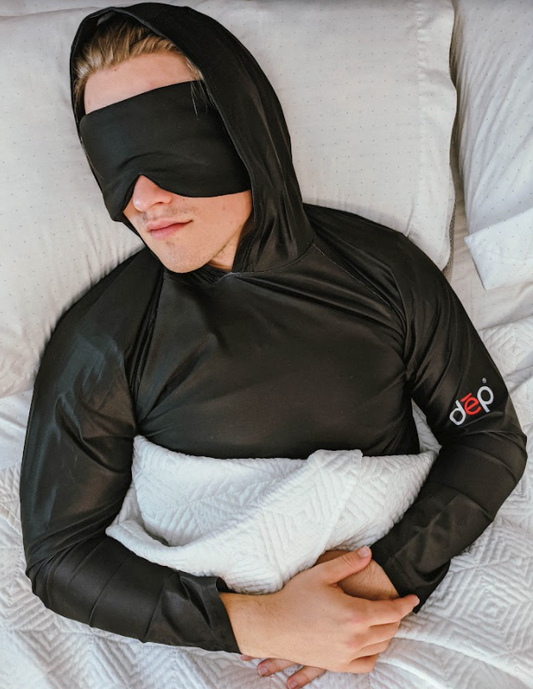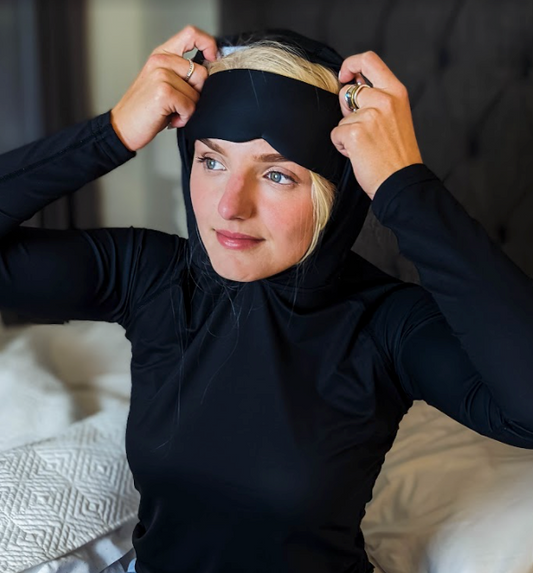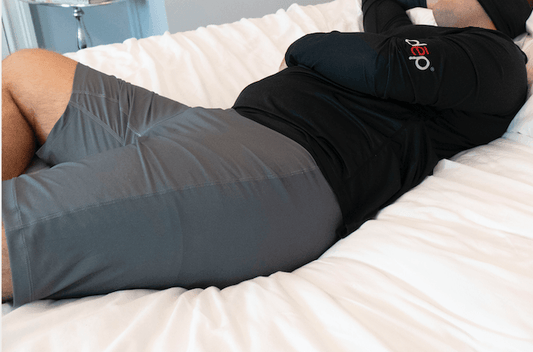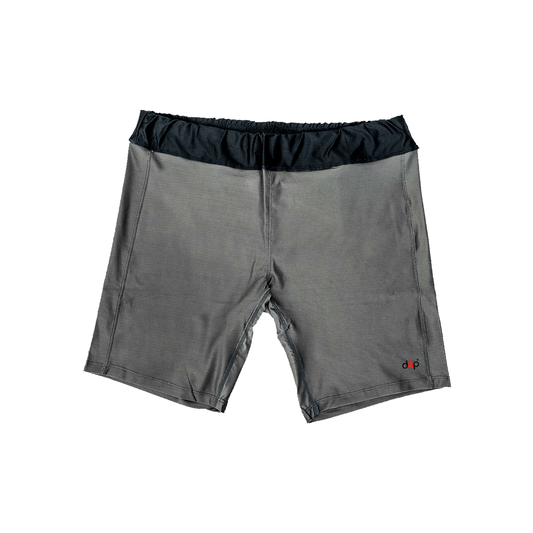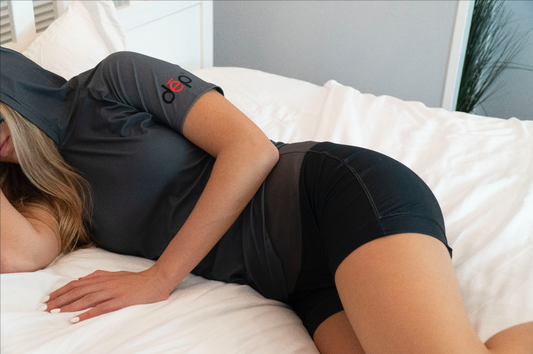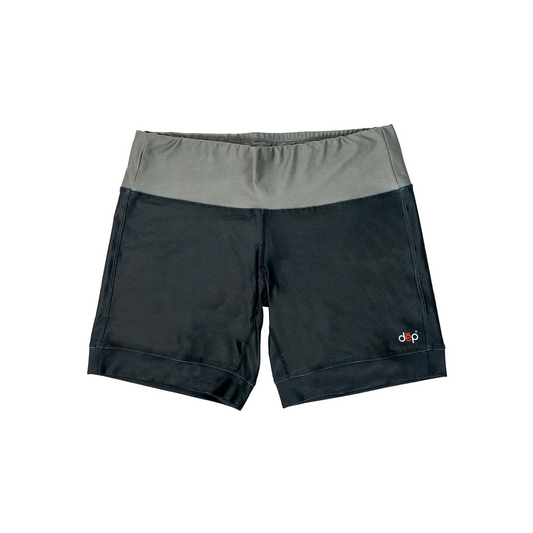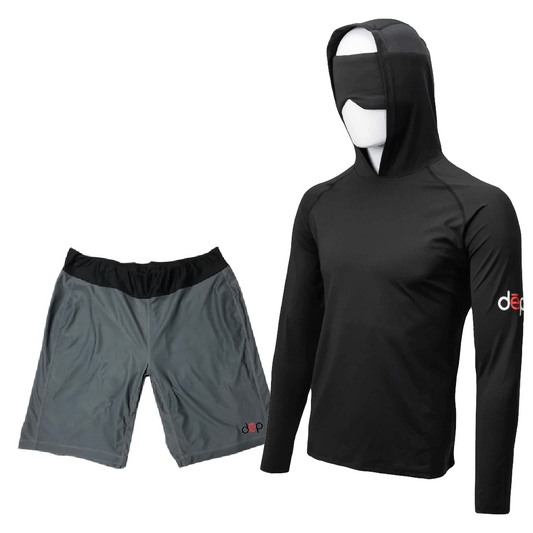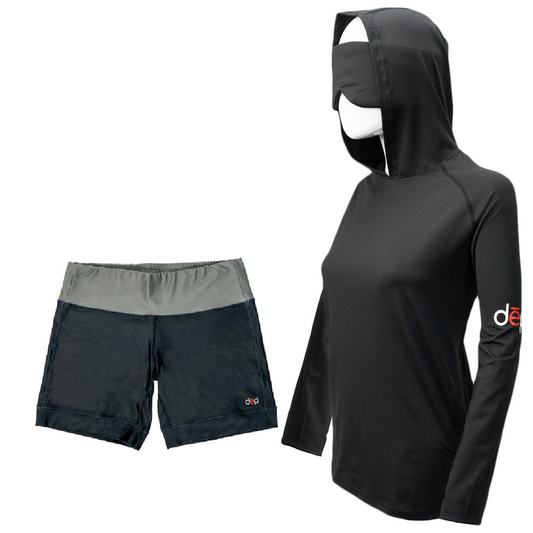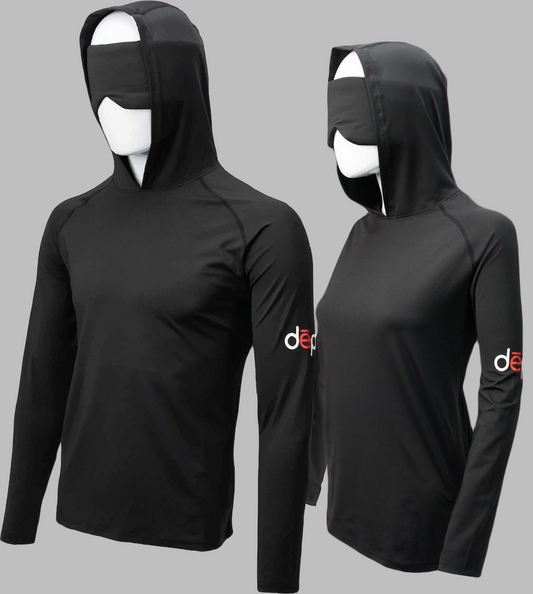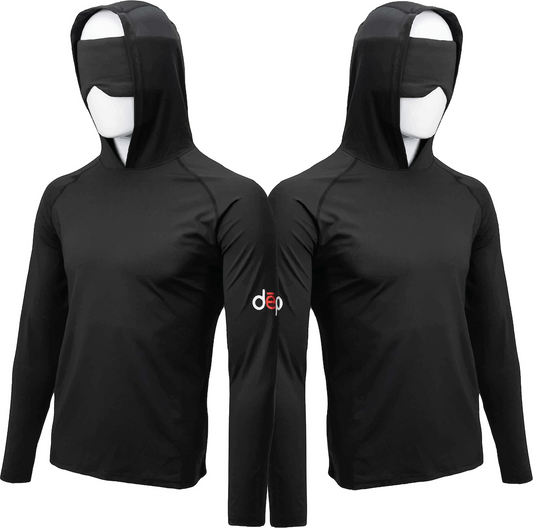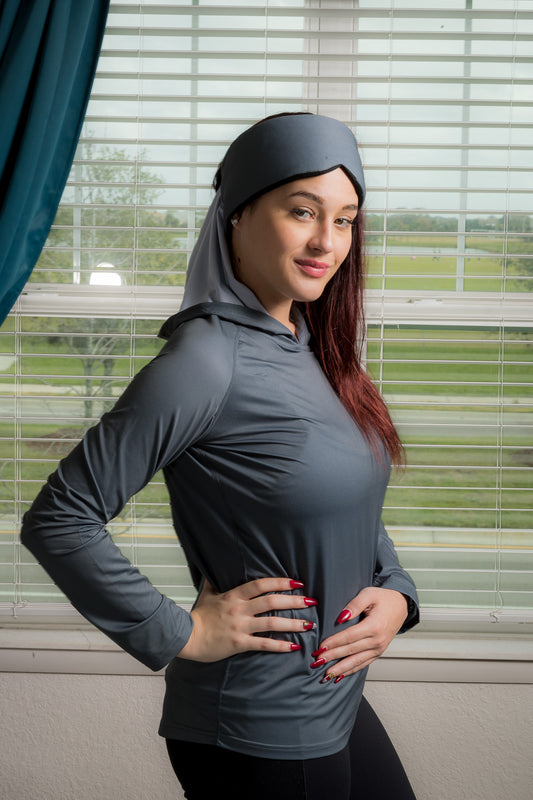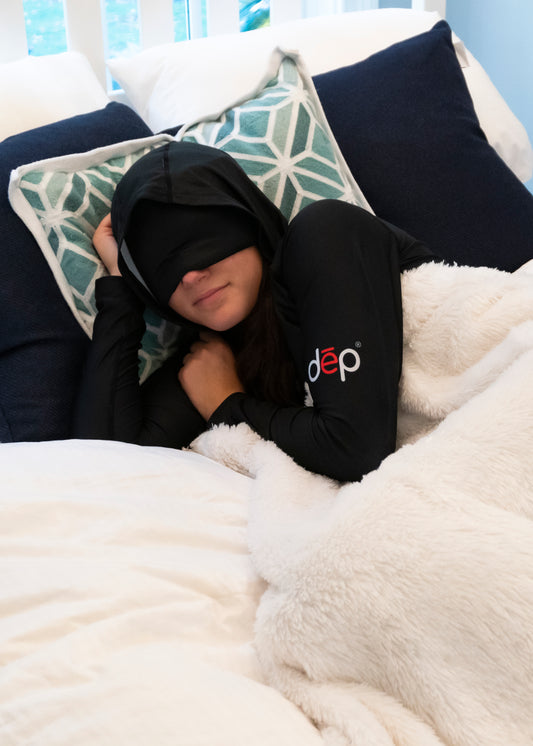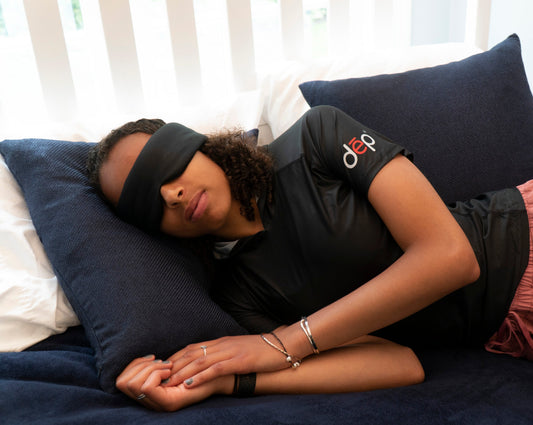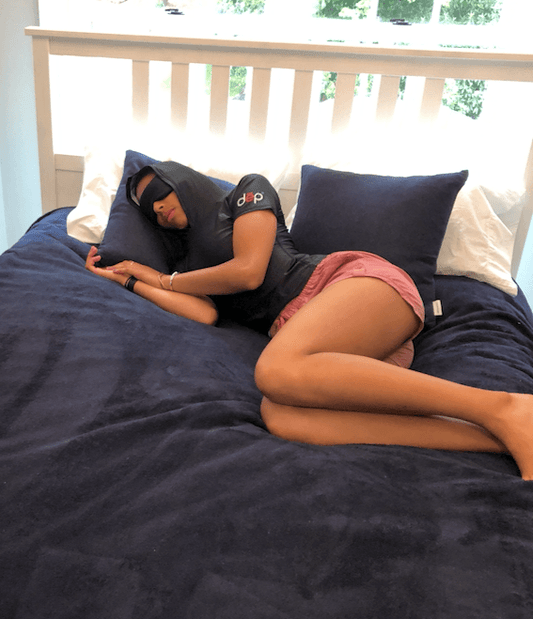Collection: The Best Pajamas for Travel
Whether you’re crossing time zones, crashing in yet another hotel, or off to the vacation of your dreams, great sleep makes every trip better.
Dēp Slēpwear’s temperature-regulating pajamas top doubles as your favorite travel hoodie to help you sleep better on the road, in the air, and anywhere you lie your head.
Get one for your Go Bag now.
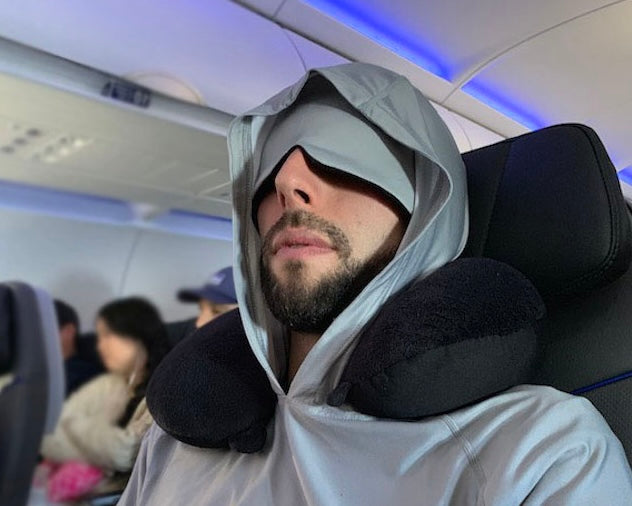
Everything you need for better sleep on the road
-
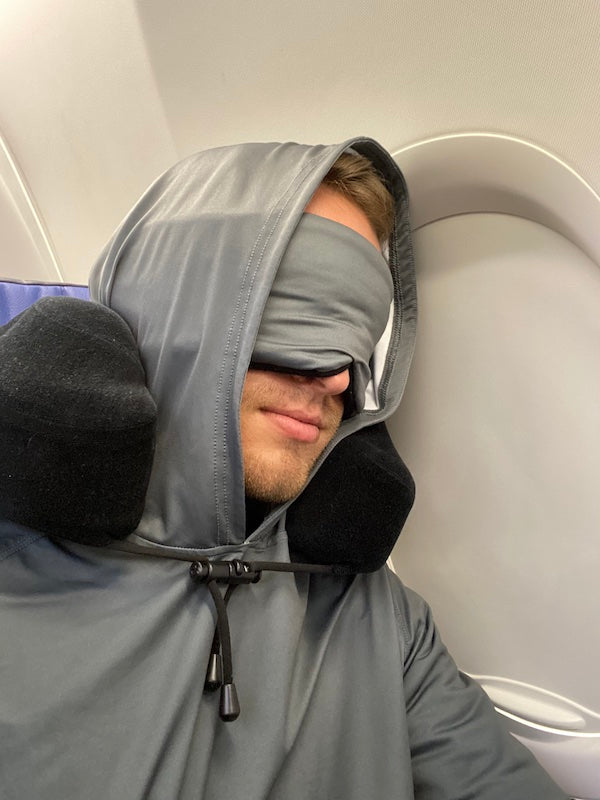
Blocks Light & Sound
The built-in sleep mask blocks all light and covers ears to create a dark, quiet space amidst the chaos of planes, trains, hostels, and hotels.
-
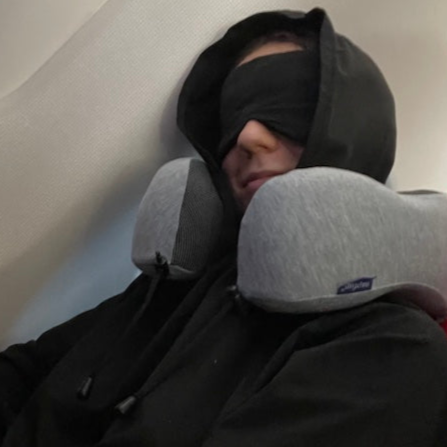
Packable
All Dēp Slēpwear travel pajamas fold down to fit even the smallest carry on or go bag so you can sneak in sleep wherever you go.
-
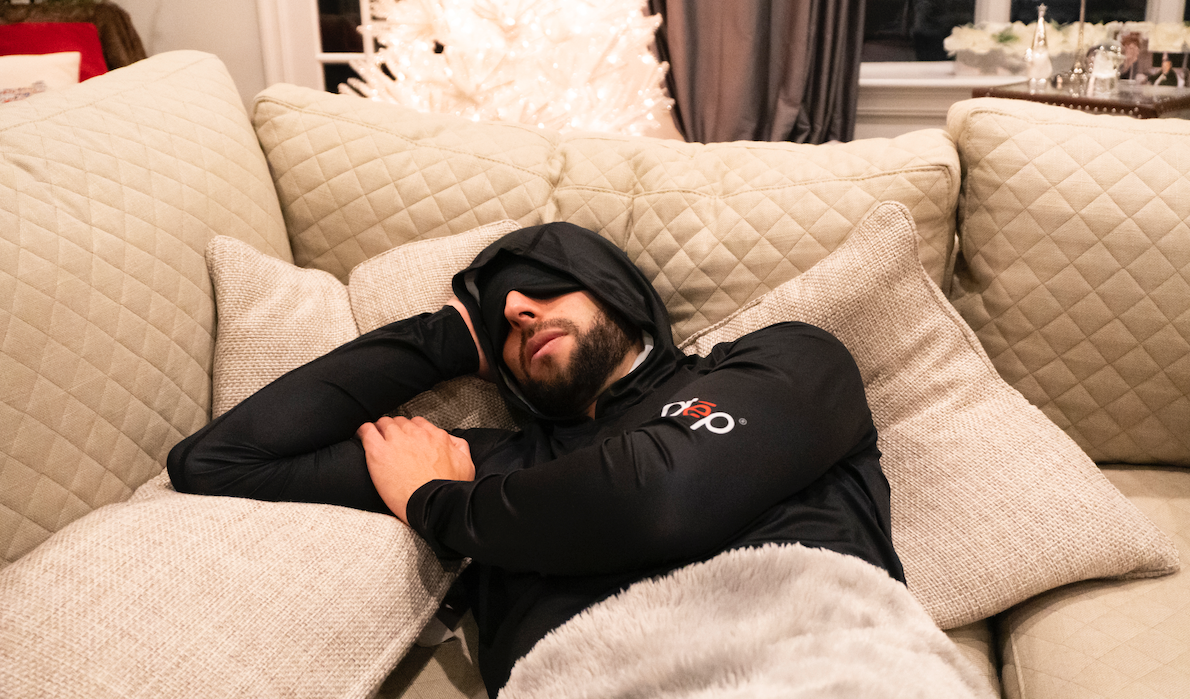
Versatile
This is specialized sleep gear that is just as comfortable in the air as it is on the way to the airport, in the airport, and even at your in-laws.
-
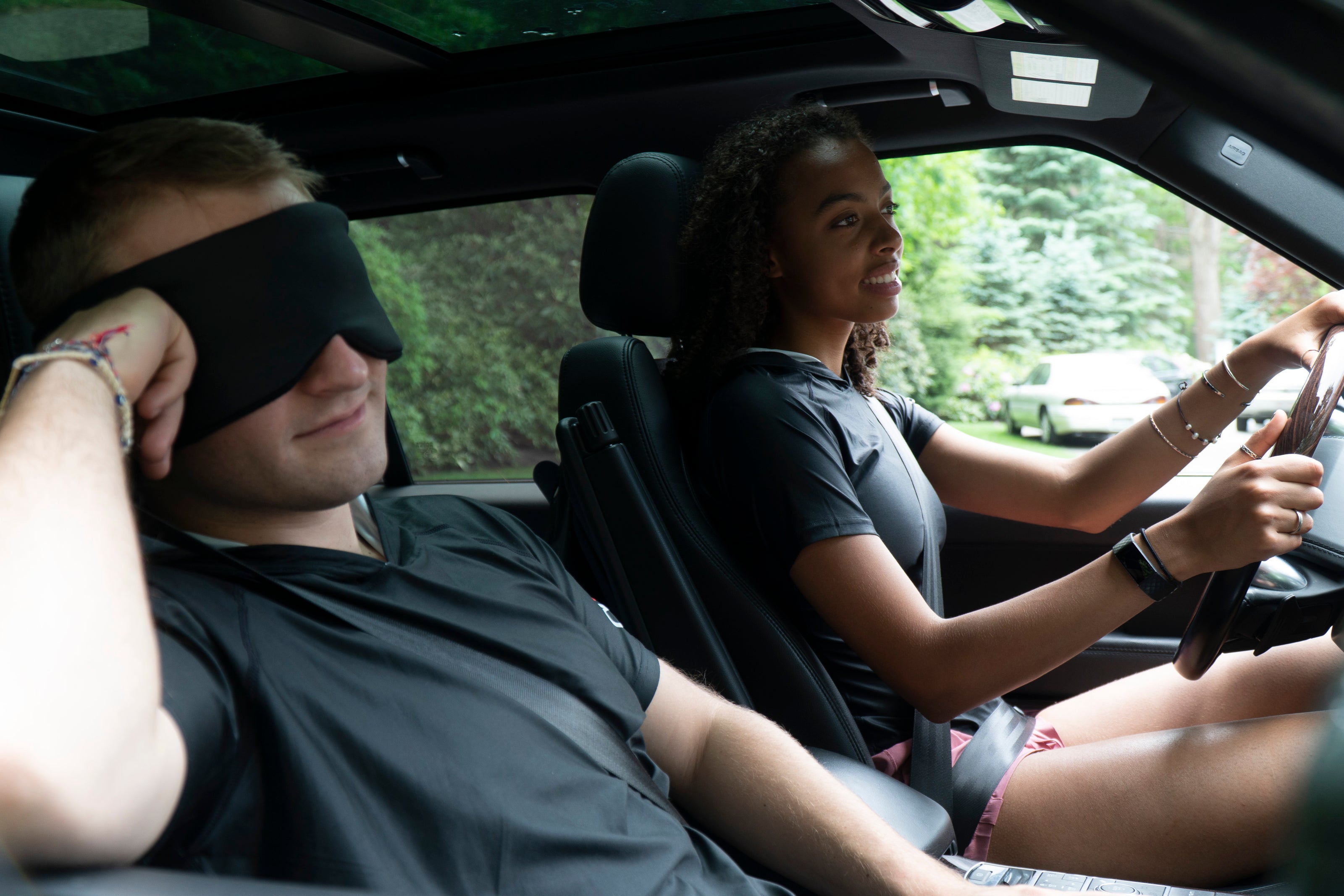
Private & Personal
The Sleep Hoodie's built-in sleep mask works together with the lightweight hood to make any space your own personal sleep cocoon.
"The Dēp Sleep Hoodie is a must-have in my go bag. I never travel without it."
Dēp Slēpwear's collection of performance travel pajamas features a patented design that's proven to help people achieve better sleep quality, wherever they are, and wherever they go. Unlike ordinary sleepwear, our cooling pajamas are engineered with advanced moisture-wicking fabrics, and are just as comfortable to wear (and be seen in!) in your home or out in public. The movement-friendly design, and innovative features help create the perfect sleep environment wherever and whenever you are ready to rest.
-
Patented Sleep Hoodie with Sleep Mask for Better Sleep
Regular price $99.00 USDRegular price -
Men's Lightweight Sleep Shorts
Regular price $49.00 USDRegular price -
Women's Lightweight Sleep Shorts
Regular price $49.00 USDRegular price -
Men's 2.0 Sleep Uniform - SAVE 15%
Regular price $125.00 USDRegular price -
Women's 2.0 Sleep Uniform - SAVE 15%
Regular price $125.00 USDRegular price -
Unisex Black Sleep Hoodie 2-Pack - SAVE 10%
Regular price $178.00 USDRegular price -
Women's Lightweight Long Sleeve Sleep Hoodie
Regular price $99.00 USDRegular price -
Women's Lightweight Short Sleeve Sleep Hoodie
Regular price $99.00 USDRegular price
The Best Travel Pajamas for Business Travelers and Vacationers: Recovery Sleepwear for Hotels, Flights, and Unfamiliar Sleep Environments
Whether you're a road warrior navigating back-to-back meetings across time zones or an adventure seeker maximizing every moment of a hard-earned vacation, quality sleep away from home isn't a luxury—it's essential infrastructure for performance. Dēp Slēpwear's patented sleep technology transforms challenging travel environments into restful sanctuaries, helping you recover from flights, adapt to unfamiliar beds, and wake ready to perform. Unlike ordinary travel clothing, our clinically-proven sleepwear actively combats the specific factors that sabotage sleep in hotels, airplanes, and guest rooms: temperature fluctuations, disruptive light and noise, uncomfortable bedding, and restricted movement. When you've invested time and money in your journey, Dēp Slēpwear protects that investment by ensuring you're mentally sharp and physically prepared for what matters most.
Why Travel Destroys Sleep (And Why That Matters More Than You Think)
The mathematics of travel sleep are unforgiving. A business traveler losing two hours of sleep per night across a four-day trip accumulates an eight-hour sleep debt—equivalent to pulling an all-nighter before that crucial presentation. A family that saved all year for a week-long adventure can lose 30% of their waking vacation hours to jet lag grogginess and fatigue. Your body doesn't distinguish between a $500-per-night hotel and your bedroom at home; it simply knows something is wrong.
The Science of Travel Sleep Disruption
Sleep researchers have identified multiple mechanisms by which travel undermines rest, and understanding these helps explain why typical solutions fall short. Your circadian rhythm—the internal biological clock governing sleep-wake cycles—operates on approximately 24-hour cycles synchronized to environmental cues. Air travel across time zones forcibly desynchronizes this system. Your body insists it's 3 AM while the hotel clock reads 10 PM, creating a neurological conflict that cascades through multiple physiological systems.
The hypothalamus, your brain's master regulator, coordinates sleep timing through light exposure detected by specialized retinal cells. Hotel rooms present a chaotic light environment: unfamiliar LED alarm clocks, hallway light bleeding under doors, early sunrise through unfamiliar window coverings. Even small amounts of light—as little as 8 lux, roughly equivalent to a nightlight—can suppress melatonin production by up to 50%, according to research published in the Journal of Clinical Endocrinology & Metabolism.
Temperature regulation during sleep is equally critical and equally compromised during travel. Core body temperature naturally decreases by 1-2 degrees Fahrenheit during the night, facilitating the transition into deeper sleep stages. Hotel climate control systems, however, operate on different principles than home thermostats. That "one temperature fits all" approach means you're either shivering at 68°F or sweating at 74°F, with minimal middle ground. Airplanes present an even more hostile environment, with cabin temperatures varying wildly between zones and humidity levels dropping to desert-like 10-20% compared to the comfortable 30-50% at home.
The Hidden Costs of Poor Travel Sleep
For business travelers, sleep deprivation creates measurable performance deficits that undermine the entire purpose of the trip. Studies in the journal Sleep demonstrate that losing just one hour of sleep impairs cognitive function equivalent to a 0.10% blood alcohol level—legally drunk in most jurisdictions. Complex decision-making, creative problem-solving, and interpersonal sensitivity all decline significantly after poor sleep. That deal you're flying across the country to close? You're negotiating it at a physiological disadvantage.
The financial implications are substantial. A Harvard Medical School study estimated that sleep deprivation costs U.S. companies $63.2 billion annually in lost productivity. For individual business travelers, the calculus is personal: you're paying premium prices for flights, hotels, and meals while performing at diminished capacity because you couldn't sleep in a strange bed.
Vacation travelers face equally frustrating losses, though the currency is different. You've allocated limited vacation days, researched destinations, coordinated schedules, and saved for months. Poor sleep during travel doesn't just make you tired—it diminishes your capacity for joy, reduces your patience with travel companions, impairs memory formation (meaning you'll remember less of your trip), and decreases your physical stamina for activities. That sunrise hike or museum tour becomes an ordeal rather than a highlight.
Why Standard Travel Sleep Solutions Miss the Mark
The conventional wisdom on travel sleep—melatonin supplements, blackout curtains, white noise apps—addresses symptoms rather than the fundamental challenge: your body is trying to sleep in an environment it perceives as threatening. Evolutionary biology has programmed humans to sleep poorly in unfamiliar environments; our ancestors who slept soundly in strange caves didn't pass on many genes.
Travel clothing companies offer "travel pajamas" that are really just compact loungewear—soft cotton sets that pack small but do nothing to address the actual mechanisms of sleep disruption. They don't regulate temperature when hotel AC fluctuates. They don't block the light from a hotel alarm clock. They don't reduce the noise of hallway conversations or ice machines. And critically, they bunch and bind against hotel sheets with high thread counts, meaning every time you shift position, you're partially waking yourself.
What Actually Works: The Science of Recovery Sleepwear for Travel
Effective travel sleepwear must function as a wearable sleep environment—a portable cocoon that recreates the optimal conditions for rest regardless of external circumstances. This requires addressing temperature regulation, light exposure, acoustic environment, tactile comfort, and movement freedom simultaneously. Dēp Slēpwear's patented technology is specifically engineered for these multifaceted challenges.
Advanced Moisture-Wicking and Temperature Regulation
The fabric technology in Dēp Slēpwear actively manages the microclimate between your skin and the garment. Unlike cotton, which absorbs moisture and holds it against your body, our select blend wicks perspiration away from skin and disperses it across a larger surface area for rapid evaporation. This is particularly crucial in travel environments where you have no control over ambient temperature.
On airplanes, where you might be warm during boarding and cold at cruising altitude, the fabric responds dynamically to your body's needs. The moisture-wicking properties also prevent the clammy sensation that occurs when you fall asleep warm on a plane and wake up cold with damp clothing clinging to your skin—a guaranteed way to disrupt sleep cycles.
The lightweight construction provides warmth without weight or bulk, making these the best lightweight pajamas for travel. They pack into a carry-on without taking valuable space, yet provide sufficient warmth for over-air-conditioned hotels while preventing overheating if the room runs warm.
The Sleep Cocoon Effect: Light and Sound Management
The hood design in Dēp Slēpwear isn't a fashion choice—it's a clinically-informed solution to light and noise pollution. The hood creates a personal dark environment regardless of hotel light leakage, allowing your brain's suprachiasmatic nucleus to maintain proper melatonin production. This is particularly valuable during daytime sleep for travelers adjusting to new time zones or recovering from red-eye flights.
The acoustic properties are equally deliberate. The hood and fabric construction provide approximately 10-15 decibels of noise reduction—enough to diminish hallway conversations, neighboring rooms, and hotel mechanical systems from disruptive to manageable. This isn't complete noise cancellation, which can feel disconcerting and unsafe in unfamiliar environments, but rather a buffering effect that allows your brain to filter ambient noise as non-threatening.
Friction-Free Movement: The Overlooked Factor
One of the most underappreciated aspects of travel sleep disruption is bedding incompatibility. Hotel sheets, with their high thread counts and crisp finishes, create friction against typical pajama fabrics. This means that when you shift position during the night—which happens naturally every 10-20 minutes during healthy sleep—your pajamas bind and pull, partially waking you.
Dēp Slēpwear's fabric is engineered with a low-friction exterior surface that slides smoothly over any bedding. This allows for natural position changes without the micro-disruptions that fragment sleep architecture. You maintain deeper sleep stages longer, achieving more restorative rest in the same time window.
The interior surface, in contrast, maintains gentle contact with skin without binding or bunching. This combination—smooth exterior, soft interior—means the sleepwear moves with you rather than against you, working seamlessly whether you're in a luxury hotel, a budget motel, a friend's guest room, or an airplane seat.
Maximizing Your Travel Investment Through Better Sleep
The return on investment for quality travel sleepwear is remarkably straightforward. If you travel 10 nights per year for business and Dēp Slēpwear helps you gain even 30 minutes of quality sleep per night, you've added 5 hours of rest to your year. Those hours translate directly into sharper presentations, better negotiations, and reduced stress.
For vacation travelers, the calculation is even more compelling. A week-long trip represents a significant portion of annual leisure time. Arriving well-rested and adapting quickly to new time zones means more usable vacation hours. Better sleep also enhances memory consolidation, helping you retain those vacation experiences more vividly.
Practical Integration with Other Travel Sleep Strategies
While Dēp Slēpwear addresses the fundamental physiological challenges of travel sleep, combining it with other evidence-based strategies amplifies results:
Light exposure management: Upon arrival at your destination, seek bright light exposure during your desired wake period. The combination of appropriate light exposure while awake and light blocking during sleep (via the hood) accelerates circadian adaptation.
Strategic caffeine timing: Avoid caffeine within 6 hours of intended sleep time. The moisture-wicking properties of Dēp Slēpwear become particularly valuable if you've miscalculated and are experiencing caffeine-related temperature fluctuations.
Pre-sleep routine consistency: Maintain the same pre-sleep routine you use at home. Put on your Dēp Slēpwear at the same point in this routine—it becomes a psychological cue that sleep is approaching, helping trigger the physiological sleep preparation cascade even in unfamiliar environments.
Strategic napping: If crossing multiple time zones, a 20-minute nap in your Dēp Slēpwear can provide restorative benefits without the deep-sleep grogginess of longer naps. The light-blocking hood makes daytime napping more feasible.
Special Considerations for Different Types of Travel
Red-eye flights: The best sleepwear for airplanes needs to function in the most challenging environment—cramped seats, constant activity, temperature swings, and persistent noise and light. Dēp Slēpwear's hood becomes essential here, creating a personal dark zone despite cabin lighting. The lightweight, packable design means you can change in the airplane bathroom before attempting sleep.
International business travel: When you're crossing many time zones with immediate performance expectations, every minute of quality sleep matters. The combination of light control, temperature regulation, and movement comfort in Dēp Slēpwear helps you capture restorative sleep even when your body insists you should be awake.
Adventure travel: Backcountry lodges, camping, hostels—adventure travel often means the least predictable sleep environments. Dēp Slēpwear provides consistency: the same temperature regulation, light control, and comfort regardless of whether you're in a tent, a bunk bed, or a mountain hut.
Multi-hotel itineraries: Tours and road trips mean a different bed every night or two. The sleep fragmentation from constantly adapting to new environments is cumulative. Bringing your own sleep environment in the form of Dēp Slēpwear provides an anchor of consistency.
Beyond Cotton: Why Fabric Technology Matters for Travel
The textile industry has developed remarkable innovations in performance fabrics, yet most travel pajamas remain cotton-based. Cotton's limitations become particularly apparent in travel contexts:
Moisture retention: Cotton can absorb up to 27 times its weight in water, meaning perspiration stays against your skin rather than evaporating. In climate-controlled hotel rooms where temperature can swing several degrees, this creates cycles of dampness and chill.
Bulk and weight: Cotton pajamas suitable for cool hotel rooms are too heavy to pack efficiently. Lightweight cotton suitable for warm destinations doesn't provide adequate warmth when AC is aggressive.
Friction and binding: Cotton's natural texture creates friction against hotel bedding, disrupting the smooth movement essential for uninterrupted sleep.
Slow drying: If you need to wash travel pajamas in a hotel sink, cotton can take 24+ hours to dry thoroughly—problematic for travelers on tight schedules.
Dēp Slēpwear's select fabric blend addresses each limitation while maintaining the soft, comfortable feel that invites sleep. The material is substantially lighter than cotton of equivalent warmth, dries in hours rather than days, and maintains consistent performance through dozens of wash cycles.
The Travel Pajama Checklist: What to Look for
Not all travel sleepwear is created equal. When evaluating the best travel pajamas for your needs, consider:
Weight-to-warmth ratio: Effective insulation without bulk or heavy weight. You want pajamas that pack into a carry-on without dominating your luggage but still provide adequate warmth.
Moisture management: Active wicking properties rather than absorption. Your sleepwear should move moisture away from skin, not hold it.
Movement freedom: Non-restrictive fit that allows natural sleep position changes without binding, combined with low-friction exterior for smooth movement over any bedding.
Multi-environment adaptability: Performance across temperature ranges from over-air-conditioned planes to warm hotel rooms.
Light control: Effective hood or eye covering that blocks ambient light without pressure on eyes.
Acoustic buffering: Some degree of noise reduction to help filter disruptive sounds.
Durability: Fabrics and construction that maintain performance through frequent washing and packing.
Quick-drying properties: The ability to wash and dry overnight for extended travel.
Psychological comfort: Sleep is as much psychological as physiological. Your travel pajamas should feel like a familiar comfort item that signals safety and rest.
Dēp Slēpwear is specifically engineered to excel in every category—not a compromise between conflicting priorities, but a comprehensive solution to the multifaceted challenge of travel sleep.
Sources
- Journal of Clinical Endocrinology & Metabolism - Studies on light exposure and melatonin suppression
- Harvard Medical School, Division of Sleep Medicine - Research on sleep deprivation costs and cognitive impacts
- Sleep Research Society - Studies on sleep architecture and position change frequency
- National Sleep Foundation - Guidelines on optimal sleep temperature and environment
- Journal of Travel Medicine - Research on jet lag, circadian disruption, and travel fatigue
- Aerospace Medical Association - Studies on cabin environment effects on sleep quality
- American Academy of Sleep Medicine - Clinical guidelines for sleep hygiene and environment optimization
- Journal of Biological Rhythms - Research on circadian rhythm disruption and adaptation
- International Journal of Environmental Research and Public Health - Studies on noise exposure and sleep fragmentation
- Textile Research Journal - Research on fabric properties, moisture management, and thermal regulation
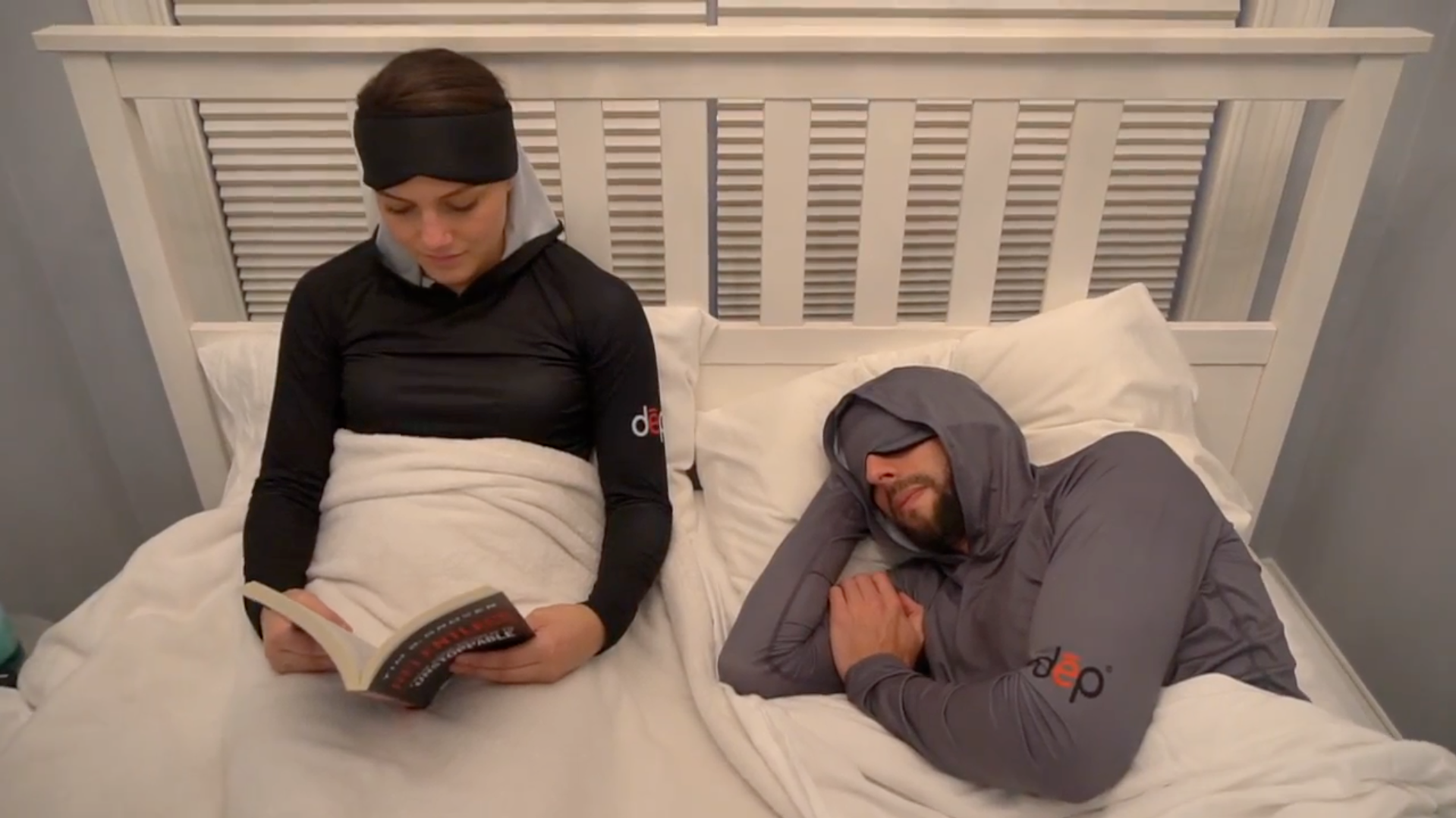
Try it Risk Free
Wear it for 30 days. If you don't love it, ship it back for a full refund.
Frequently Asked Questions
How should Dēp Slēpwear fit, and what size is best for me?
For best results, all Dēp Slēpwear should fit somewhat close to the skin. That said, for Dēp Sleep Hoodies, we generally recommend ordering your t-shirt size. Note: our unisex sizes are closer to men's standard sizes, so for women, we recommend ordering a size or two down. For Dēp Sleep Shorts, order your normal shorts size. If you are between sizes, get a size down from your normal size. You can take a look at the Size Chart links on the product pages if you'd like to see detailed dimensions for each size.
What material is Dēp Slēpwear made of?
Dēp Slēpwear is constructed of a lightweight blend of performance polyester and elastane. This blend is used specifically to promote better sleep naturally in three main ways: 1. Active temperature regulation 2. Moisture wicking 3. Frictionless movement
What are the best travel pajamas for frequent business travelers?
The best travel pajamas for business travelers need to deliver consistent, restorative sleep across different hotels, time zones, and trip durations while packing efficiently. Look for moisture-wicking fabric that regulates temperature regardless of hotel AC settings, a hood or light-blocking feature for varying light conditions, low-friction material that moves smoothly over any hotel bedding, and lightweight construction that doesn't consume valuable luggage space. Dēp Slēpwear's patented technology addresses all these requirements—it's designed specifically for the unique sleep challenges road warriors face, helping you arrive ready to perform regardless of travel conditions.
What should I wear to sleep on a long flight?
The best sleepwear for airplanes must function in uniquely challenging conditions: limited space, temperature fluctuations, persistent light and noise, and the inability to adjust your environment. Ideal airplane sleepwear includes a hood to block cabin light without the pressure of traditional sleep masks, moisture-wicking fabric to handle temperature swings between boarding and cruising altitude, lightweight material that doesn't add bulk in cramped seats, and a non-restrictive fit that accommodates limited movement. Dēp Slēpwear checks every box—the hood creates a personal dark zone for daytime flights, the fabric manages the temperature roller coaster of air travel, and the design allows comfortable rest even in economy seating.
How can I sleep better in hotels and unfamiliar environments?
Sleeping well in hotels requires addressing both physiological and psychological factors. Create environmental consistency by bringing your own sleep equipment—particularly sleepwear that provides familiar comfort, light control, and temperature regulation regardless of room conditions. Dēp Slēpwear functions as a portable sleep environment: the hood blocks light from unfamiliar sources (alarm clocks, hallway gaps, early sunrise), the moisture-wicking fabric compensates for hotel temperature control issues, and the smooth-gliding exterior works with any bedding type. The psychological benefit is equally important—putting on familiar sleepwear signals your body that it's time to rest, helping trigger sleep onset even in strange beds.
Are lightweight pajamas better for travel than regular pajamas?
Lightweight pajamas for travel offer significant advantages: they pack efficiently without consuming luggage space, reduce weight for carry-on bags, dry quickly if you need to wash them during extended trips, and provide versatility across different climates. However, "lightweight" doesn't mean "less effective"—the key is advanced fabric technology that provides warmth without bulk. Dēp Slēpwear's proprietary blend achieves optimal weight-to-warmth ratio, offering the coverage and insulation you need for air-conditioned hotels and planes while remaining light enough that you barely notice them in your luggage. You gain all the benefits of lightweight travel gear without sacrificing sleep quality.
What's the difference between vacation pajamas and regular sleepwear?
Vacation pajamas need to perform reliably across unpredictable environments while maximizing your enjoyment of limited vacation time. Unlike regular sleepwear designed for your consistent home environment, vacation pajamas must handle various hotels or accommodations, quick adaptation to new time zones, possibly limited washing opportunities, changing climate conditions, and compact packing requirements. The best vacation pajamas function as travel insurance for your trip investment—they help you adapt quickly, recover from travel fatigue, and wake refreshed for adventure rather than groggy from poor sleep. Dēp Slēpwear transforms any sleep environment into a restful space, protecting the time and money you've invested in your vacation.
Do I need special pajamas for red-eye flights?
Red-eye flights present perhaps the most challenging sleep environment: you're attempting to rest while seated upright, surrounded by noise and activity, under artificial lighting, with temperatures fluctuating throughout the flight. While you can attempt sleep in regular clothing, specialized sleepwear dramatically improves your chances of actual rest. The critical features are effective light blocking (a hood works better than masks that create pressure on eyes), temperature regulation for cabin climate swings, and comfort in restricted positions. Dēp Slēpwear's design specifically addresses red-eye challenges—the hood creates darkness regardless of cabin lighting, the moisture-wicking fabric handles temperature changes, and the comfortable, non-restrictive fit works even in economy seating.





